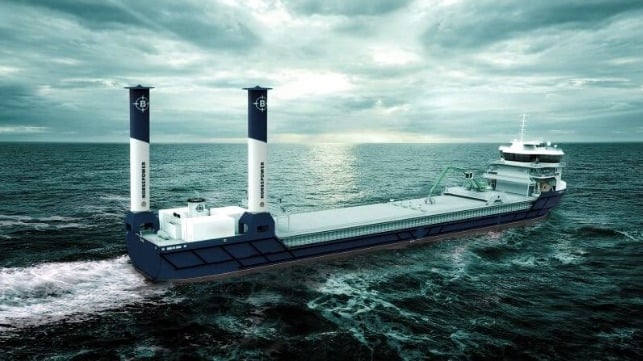Battery-Powered Bulkers to Use Wind Rotors Optimized for Harsh Conditions

Berge Rederi will incorporate two specially designed wind rotor sails from Norsepower into its innovative zero-emission bulk carriers now building in Nanjing, China. The company reports the vessels expected to launch starting late this year will be the world’s largest battery-powered bulk carriers and far surpass the current longest voyages for battery-electric ferries.
The two cutting-edge general cargo ships are designed to operate entirely without emissions while transporting marble from Brønnøy and Visnes along the Norwegian Sea coast of Norway to the Omya Hustadmarmor production plant in Elnesvågen to be processed into calcium carbonate. Each of the vessels, which will be 13,250 dwt and 426 feet (129.9 meters) in length will sail a distance of approximately 230 nautical miles. According to Berge, this will set a record compared to the current longest battery-ferry route of just 15 nautical miles.
The vessel’s propulsion system is powered by a 23.5 MWh battery package which will be supplemented with shaft generators and two fixed 24 x 4 meter (79 x 13 foot) Norsepower Rotor Sails. Norsepower highlights the rotors are being specially optimized for the harsh conditions, including snow, ice, rain, and high winds, often encountered along the Norwegian Sea route.
“This project was designed for the extreme conditions of the Northen Sea, and we are proud that Berge Rederi chose Norsepower as their partner,” said Marcus Sannholm, Head of Sales at Norsepower. “Our product has been in use at tough sea conditions for more than a decade now, which enables us to create these kinds of partnerships with innovative, market-leading companies. By working with Berge Rederi and MDC from the design phase, we’ve ensured that these vessels will set a new benchmark for sustainability and efficiency in their class.”
Norsepower is collaborating with Berge Rederi and the Norwegian ship designer Marine Design and Consulting for the development of the systems. Through extensive hydrodynamic and structural studies, the teams optimized the vessels’ performance and ensured that the Norsepower Rotor Sails would deliver maximum savings and reliability. The latest high-tech materials will ensure reliable operation for the rotors in the rough sea conditions.
“We’re excited to partner with Norsepower and MDC on this transformative project,” said Magne Berge, owner of Berge Rederi. “The combination of hybrid propulsion and Norsepower Rotor Sails aligns perfectly with our mission to minimize our environmental footprint while maintaining the highest standards of operational efficiency.”
The vessels are being built by Jiangsu SOHO Marine Heavy Industry Co. with the first one scheduled to be delivered with the rotor sails installed by the end of 2025. Supporting the operation will be charging stations at the ports in Remman (Brønnøy) and Elnesvågen. Additionally, an electric excavator and shore power connections will be used at both ports to maintain fully emission-free cargo operations.
Berge reports that the rotor sails are expected to contribute to an average power savings of 339 kW per voyage. Each vessel is expected to annually cut CO2 emissions by around 9,000 tons and NOx emissions by 200 tons.
Based in Hitra, Norway, Berge Rederi operates a fleet of nine self-discharging bulk cargo vessels ranging from 2,700 to 13,000 dwt.
The project has received backing from the Norwegian NOx Fund and Enova, and the development process has been guided by the GSP Service Centre for Green Fleet Renewal.
